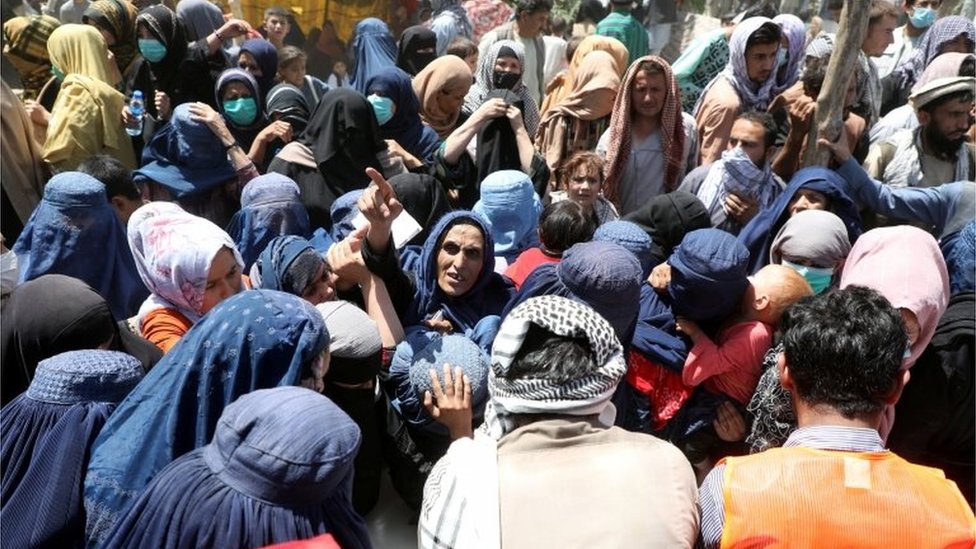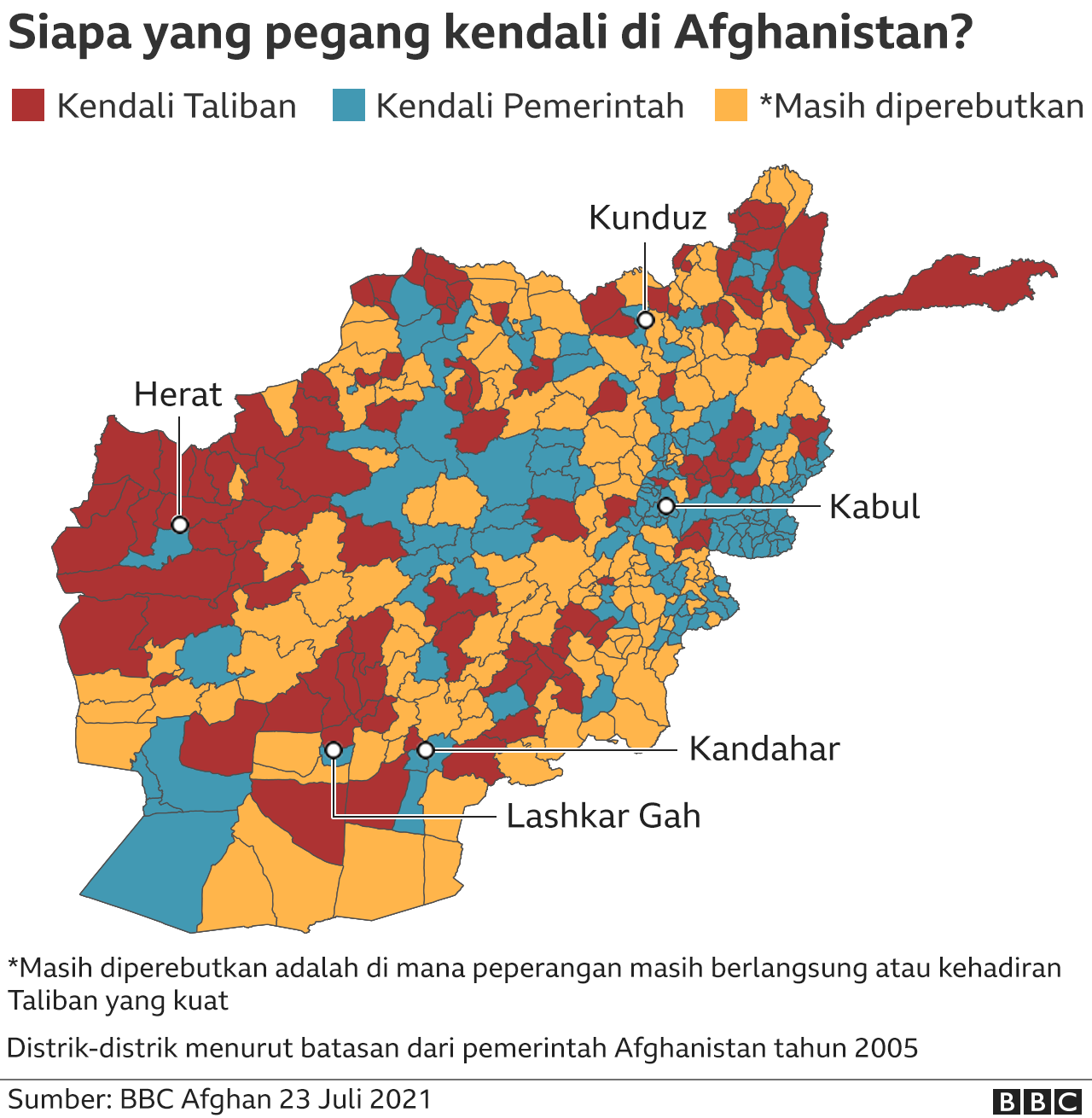Jakarta –
The pace at which the Taliban insurgency is moving in Afghanistan seems to come as a surprise to many – some regional capitals are likely to fall like dominoes.
This week, a leaked US intelligence report estimated that Kabul could be attacked within weeks, and the Afghan government could collapse in 90 days.
So far the Taliban claim to have captured Afghanistan’s second largest city, Kandahar, in what could be called a major victory for them.
The city was once a stronghold of the Taliban, and was strategically important as a prominent trading center.
Several other cities also fell on Thursday (12/08) in a series of most dramatic wins.
So how did all this happen so fast?
The US and its NATO allies – including the UK – have spent much of the past 20 years training programs and equipping Afghan security forces.
Countless American and British generals claim to have formed a stronger and more capable Afghan army. Those promises look like bullshit these days.
The power of the Taliban
The Afghan government should, in theory, still have the upper hand with more power at its disposal.
The Afghan security forces number more than 300,000 people, at least on paper. That number includes the Afghan army, air force and police.
Also read:
Afghan soldiers and police have historical problems of high mortality, desertion and corruption. (EPA)
However, the reality is that this country has always struggled to meet the target of recruiting members of the security forces.
The Afghan army and police have a bad history of high mortality, desertion and corruption – a number of unscrupulous commanders ask for a claimed budget for their troops, but in fact the soldiers never exist – the so-called “ghost army”.
In his latest report to the US Congress, the Special Inspector General for Afghanistan (SIGAR) expressed “serious concern about the damaging effects of corruption… and questions about the accuracy of the data regarding actual troop strength”.
Jack Watling, of the Royal United Services Institute, said even the Afghan Army was never sure how many troops they actually had.
In addition, he said, there are problems with the maintenance of defense equipment and morale.
Troops were often sent to areas where they had no tribal or family ties. This is one reason why some people may leave their posts so quickly without putting up a fight.
The strength of the Taliban is even more difficult to measure.
According to the US Center for Combating Terrorism at West Point, there are estimates that the core strength of the Taliban group is 60,000.
With the addition of other militia groups and supporters, their number could exceed 200,000.
But Dr Mike Martin, a former British army officer who speaks Pashto and has traced the history of the conflict in Helmand in his books An Intimate War, warned that it was too dangerous to define the Taliban as a monolithic group.
Instead, he said “the Taliban are closer to a loose coalition of independent – and likely temporary – affiliated franchisees”.
He noted that the Afghan government is also divided by the interests of various factions at the local level.
The history of change in Afghanistan illustrates how families, tribes, and even government officials have shifted their support – often to ensure their own survival.
Access to armaments
Again, the Afghan government actually has the advantage in terms of both funding and weapons.
They have received billions of dollars in salaries and defense equipment – much of it given by the US.
In a July 2021 report, SIGAR said more than US$88 billion had been spent on Afghanistan’s security.
Also read:
But the data added: “The question is whether the money is well spent, which in the end, will be answered by what results from the fighting on the ground.”
The Afghan Air Force must prove its superiority in critical situations on the battlefield.
But they had to fight to defend and man their 211 planes (which made matters worse, as the Taliban deliberately targeted the pilots).
They are also unable to meet the demands of the commander in the field.
Because of this, there has been recent US Air Force involvement in cities like Lashkar Gah, which are already under the control of the Taliban.
It remains unclear how much longer the US is willing to provide such support.
 Reuters Thousands of people have settled in makeshift camps in the capital Kabul after they fled Taliban attacks.
Reuters Thousands of people have settled in makeshift camps in the capital Kabul after they fled Taliban attacks.
The Taliban often rely on their supply of funds from the drug trade, but they also have outside support – particularly Pakistan.
Not long ago the Taliban seized weapons and equipment from Afghan security forces – some of which was supplied by the US – including Humvees, night vision equipment, machine guns, mortars and artillery equipment.
 BBC
BBC
Afghanistan was awash with weapons after the Soviet invasion, and the Taliban have shown they can defeat far more sophisticated forces.
Think of the lethal effects of an Improvised Explosive Device (IED) – an improvised bomb – targeting US and British troops.
This factor as well as local knowledge and understanding of the battlefield has been to the Taliban’s advantage.
Focus on the north and west
Despite the distinct character of the Taliban, there are several things that prove that they have a coordinated plan for their recent advances.
Ben Barry, a former British army chief and currently a senior adviser at the Institute of Strategic Studies, acknowledged the Taliban’s gains may be opportunistic, but added: “If you’re writing an operation plan, I’d be hard-pressed to come up with anything better than this.”
He pointed to the focus of the Taliban’s offensive in the north and west, which are not their traditional pockets of power in the south, where successive regional capitals have fallen to them.
The Taliban have also seized border crossing areas and key checkpoints, which supply much-needed customs revenue from the budget-poor Afghan government.
They have also increased the targeting of assassinations against key officials, human rights activists, and journalists.
Slowly but surely they are wiping out some of the small gains made over the last 20 years.
As for the Afghan government’s strategy for dealing with the Taliban, it is proving more difficult to define.
Also read:
Their promise to recapture all the territory captured by the Taliban sounded empty.
Barry said there seemed to be plans to defend the big cities. Afghan commandos have been deployed to prevent the Helmand town of Lashkar Gah from falling to the Taliban.
But for how much longer?
The Afghan special forces are relatively small, around 10,000 personnel, and they are unable to put up any resistance.
The Taliban also appear to be winning the propaganda war and narrative battle.
Barry says their momentum on the battlefield has boosted morale and strengthened a sense of unity.
On the other hand, the Afghan government was under pressure, fighting each other and firing its generals.
What’s the end like enmity this?
Such a situation certainly looks bleak for the Afghan government.
But Jack Watling of RUSI said that while the Afghan military looked increasingly pessimistic, “the situation can still be saved by politics”.
If the government can reach out to tribal leaders, he said, there is still a possibility in the midst of a stalemate.
This is the view echoed by Mike Martin, pointing to the case of the return of former warlord Abdul Rashid Dostum to the city of Mazar-i-Sharif as a pivotal moment. He has cut the deal.
The summer battles were coming to an end as winter began to take their place, which made maneuvering more difficult for troops on the ground.
There is still a chance that things will come to a stalemate by the end of the year, and the Afghan government will stick to the defense of Kabul and several other major cities.
The waves can even change if the group is hit by a rift.
But today, it seems, the efforts of the US and NATO to bring peace, security, and stability in Afghanistan, are as futile as what the Soviets did before.
Watch the video ‘The Humanitarian Crisis in Afghanistan Due to the Taliban Siege’:
(ita / ita)
– .


